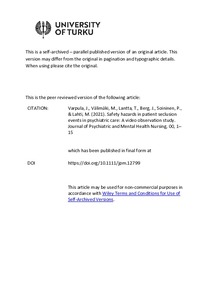Safety hazards in patient seclusion events in psychiatric care: A video observation study
Välimäki Maritta; Varpula Jaakko; Lantta Tella; Berg Johanna; Soininen Päivi; Lahti Mari
https://urn.fi/URN:NBN:fi-fe2022021619508
Tiivistelmä
Introduction: Seclusion is used to maintain safety in psychiatric care. There is still a lack of knowledge on potential safety hazards related to seclusion practices.
Aim: To identify safety hazards that might jeopardize the safety of patients and staff in seclusion events in psychiatric hospital care.
Method: A descriptive design with non-participant video observation was used. The data consisted of 36 video recordings, analysed with inductive thematic analysis.
Results: Safety hazards were related to patient and staff actions. Patient actions included aggressive behaviour, precarious movements, escaping, falling, contamination and preventing visibility. Staff actions included leaving hazardous items in a seclusion room, unsafe administration of medication, unsecured use of restraints and precarious movements and postures.
Discussion: This is the first observational study to identify safety hazards in seclusion, which may jeopardize the safety of patients and staff. These hazards were related to the actions of patients and staff. Implications for Practice Being better aware of possible safety hazards could help prevent adverse events during patient seclusion events. It is therefore necessary that nursing staff are aware of how their actions might impact their safety and the safety of the patients. Video observation is a useful method for identifying safety hazards. However, its use requires effort to safeguard the privacy and confidentiality of those included in the videos.
Kokoelmat
- Rinnakkaistallenteet [19207]
